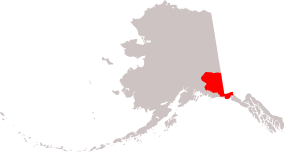Wrangell-Saint Elias National Park and Preserve
| Wrangell–St. Elias National Park and Preserve | |
|---|---|
|
IUCN category VI (protected area with sustainable use of natural resources)
|
|

Mount St. Elias, the second highest point in both the United States and Canada
|
|

The location of Wrangell–St. Elias National Park and Preserve within Alaska
|
|
| Location |
Valdez–Cordova Census Area, Yakutat City and Borough, and Southeast Fairbanks Census Area, |
| Nearest city | Copper Center, Alaska |
| Coordinates | 61°N 142°W / 61°N 142°WCoordinates: 61°N 142°W / 61°N 142°W |
| Area |
13,175,799 acres (53,320.57 km2) |
| Established | December 2, 1980 (Park & Preserve) December 1, 1978 (National Monument) |
| Visitors | 79,047 (in 2016) |
| Governing body | National Park Service |
| World Heritage Site | 1979 |
| Website | Wrangell-St. Elias National Park and Preserve |
13,175,799 acres (53,320.57 km2)
8,323,147.59 acres (3,368,258.33 ha) (Park only)
Wrangell–St. Elias National Park and Preserve is a United States national park and national preserve managed by the National Park Service in south central Alaska. The park and preserve was established in 1980 by the Alaska National Interest Lands Conservation Act. This protected area is included in an International Biosphere Reserve and is part of the Kluane/Wrangell–St. Elias/Glacier Bay/Tatshenshini-Alsek UNESCO World Heritage Site. The park and preserve form the largest area managed by the National Park Service in the United States by area with a total of 13,175,799 acres (20,587.186 sq mi; 53,320.57 km2), an expanse that could encapsulate a total of six Yellowstone National Parks. The park includes a large portion of the Saint Elias Mountains, which include most of the highest peaks in the United States and Canada, yet are within 10 miles (16 km) of tidewater, one of the highest reliefs in the world. Wrangell–St. Elias borders on Canada's Kluane National Park and Reserve to the east and approaches the U.S. Glacier Bay National Park to the south. The chief distinction between park and preserve lands is that sport hunting is prohibited in the park and permitted in the preserve. In addition, 9,078,675 acres (3,674,009 ha) of the park are designated as the largest single wilderness in the United States.
Wrangell–St. Elias National Monument was initially designated on December 1, 1978, by President Jimmy Carter using the Antiquities Act, pending final legislation to resolve the allotment of public lands in Alaska. Establishment as a national park and preserve followed the passage of the Alaska National Interest Lands Conservation Act in 1980. The park, which is bigger than the country Switzerland, has long, extremely cold winters and a short summer season. It supports a variety of large mammals in an environment defined by relative land elevation. Plate tectonics are responsible for the uplift of the mountain ranges that cross the park. The park's extreme high point is Mount St. Elias at 18,008 feet (5,489 m), the second tallest mountain in both the United States and Canada. The park has been shaped by the competing forces of volcanism and glaciation. Mount Wrangell is an active volcano, one of several volcanoes in the western Wrangell Mountains. In the St. Elias Range Mount Churchill has erupted explosively within the past 2,000 years. The park's glacial features include Malaspina Glacier, the largest piedmont glacier in North America, Hubbard Glacier, the longest tidewater glacier in Alaska, and Nabesna Glacier, the world's longest valley glacier. The Bagley Icefield covers much of the park's interior, which includes 60% of the permanently ice-covered terrain in Alaska. At the center of the park, the boomtown of Kennecott exploited one of the world's richest deposits of copper from 1903 to 1938, exposed by and in part incorporated into Kennicott Glacier. The mine buildings and mills, now abandoned, compose a National Historic Landmark district.
...
Wikipedia
